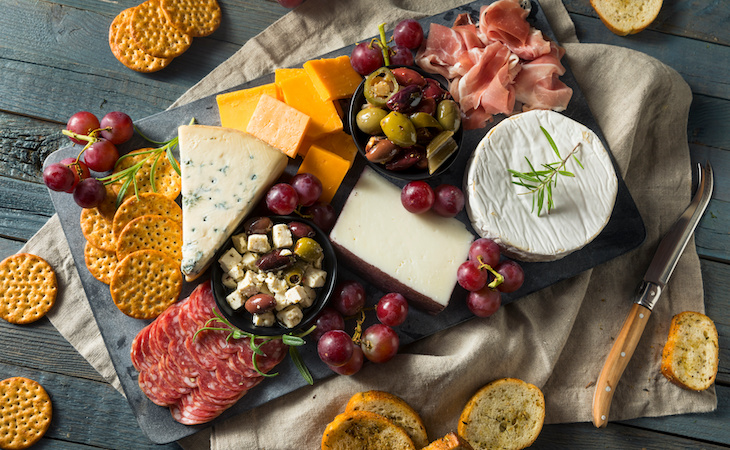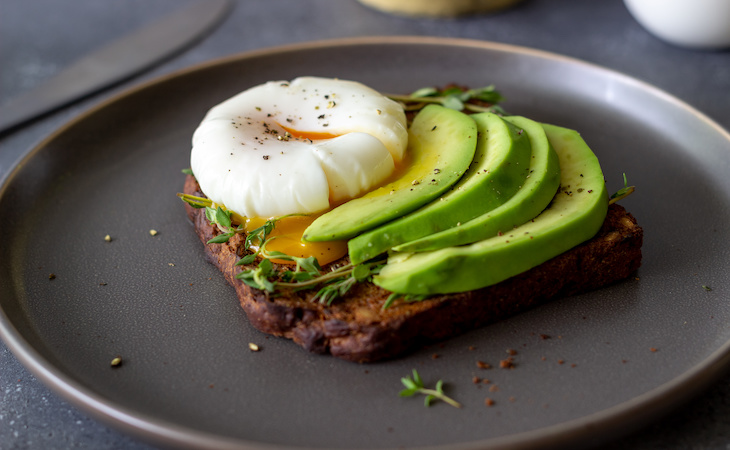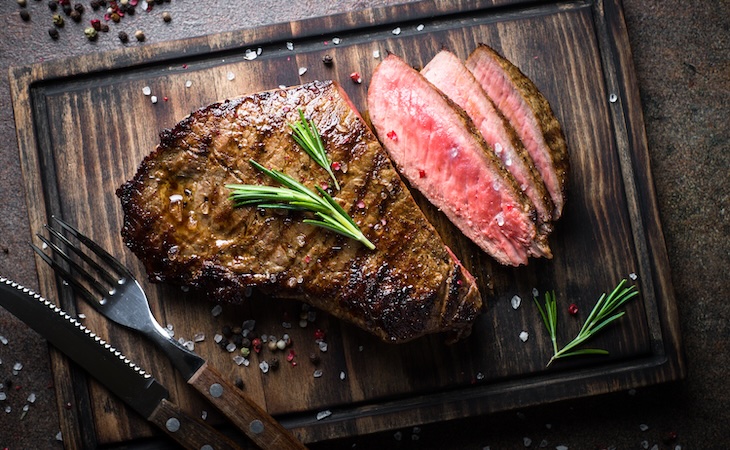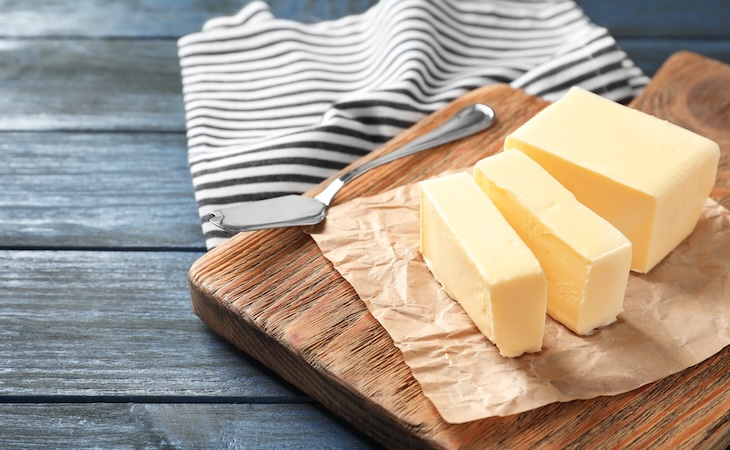Charcuterie boards and their mesmerizing displays continue to grip the attention of our eyes and tastebuds. With so many perks, including delicious flavors, visual appeal, and little to no cooking necessary, it’s no wonder these party fares have grown in popularity over the years.
One of the best parts of creating charcuterie delights is that there are hardly any rules to make them. That’s right! It’s foolproof; you don’t have to be a master chef to craft a show-stopping board. Whether it’s holiday time, football season, or time for breakfast, there’s a themed charcuterie board fit for any occasion, from wreath charcuteries to pancake boards.
To put our own twist on the charcuterie board, we’re sharing tips on how you can include the right foods for better slumber.
What is a charcuterie board?
According to Brittanica, charcuterie, which sounds like shaar-koo-ter-ee, is a French term referring to prepared meats like sausage and salami. Today, charcuterie boards go beyond offering cured meats but come chock-full of cheeses, dried fruits, pickled vegetables, nuts, and olives.
In recent years, these culinary creations have incorporated sweets (candied walnuts, chocolate-covered strawberries, yogurt pretzels) and all things savory (prosciutto, brie, marinated artichoke hearts, and crostini. With the right kitchen supplies, you can be as creative in your kitchen as you want to be.
Tools for making a charcuterie board
If you’re ready to assemble your sleep-inspired charcuterie board, then you’ll need a few kitchen items to start. Spoiler alert: You don’t need an arsenal of equipment to make a good charcuterie board.
You may need:
- A wooden cutting board (any shape)
- Utensils: spreading knife, flat knife, spear-tipped knife, cheese fork, bread knife, or dip spoon
- Small bowls for dips, spreads, jellies, or jams
What to put on a charcuterie board for better sleep
A single food won’t serve as a cure-all for sleep woes, but a well-balanced way of eating is most likely to drive healthy sleep patterns.
Consider building a snooze-promoting tray featuring foods rich in nutrients that may improve sleep quality and health, including melatonin, calcium, magnesium, potassium, and tryptophan.
Plus, check out which foods may sabotage sound sleep and consider stashing those aside for an earlier time of day.
Here’s a list of charcuterie board ideas to adorn your board divided by their sleep-boosting nutrients.
Melatonin
Charcuterie-worthy foods rich in melatonin are important to include since melatonin may win you better sleep by increasing sleep duration, according to research.
Foods that contain melatonin include:
- Fermented or fresh pepper slices
- Raw almonds
- Candied walnuts
- Unshelled pistachios
- Tart cherries
- Fresh grapes, raspberries, and strawberries
- Cherry tomatoes
Calcium
It may be challenging to fall asleep if you’re low on calcium, according to several studies. Calcium is a vital mineral for muscles, bones, and nerves, and it helps your body make melatonin.
You can find calcium in:
- Cheese cubes
- Vanilla or plain yogurt for dipping
- Citrus fruit slices
- Roasted mix nuts
- Spiced soybeans
- Smoked salmon
- Sardine dip
Magnesium
An essential mineral for sleep function, magnesium works to help you relax. It also helps your body maintain normal levels of GABA (gamma-aminobutyric acid), a chemical messenger in your brain for relaxation.
Check out these magnesium-containing foods to support your sleep routine:
- Smoky almonds
- Salted cashews
- Roasted pumpkin seeds
- Sunflower seeds
- Sliced bananas
- Avocado dip
Potassium
Potassium is known to help lower blood pressure, but it’s also helpful to your sleep cycle by improving sleep quality overall and assisting with staying asleep. Arranging your charcuterie board to include potassium-rich often adds vibrant colors and sweet flavors.
Pump up your potassium intake with the following foods:
- Banana chips
- Dried apricots
- Raisins
- Air-fried sweet potato fries
- Black bean dip
Tryptophan
The relaxation hormone is well-known for its contribution to the post-Thanksgiving meal food coma. Tryptophan is an amino acid responsible for aiding your serotonin production, which is crucial to making melatonin.
You can find tryptophan in:
- Deli turkey meat
- Whole grain crackers or pita bread
- Dates
- Cheddar cheese slices
- Chickpea hummus
- Boiled eggs
- Energy bites (made with whole oats)
How to assemble a charcuterie board
In just five simple steps, here’s how to make a charcuterie board for beginners.
1. Add bulky items first
If you’re using small bowls to hold sauces, yogurt, tapenades, aiolis, or other dips, then consider placing them onto your board first.
These items take up extra space, and putting them first can help ensure there’s enough room to arrange complementary foods nearby. That will help encourage eating them together.
2. Place the cheeses
Cheeses are another item that can take up lots of space, especially if you cut a few triangles of gouda and leave the rest of the wedge, which often looks appetizing.
If it’s cheese cubes or marinated mozzarella balls, you can group them together in a small stack or even place them in a small bowl.
3. Arrange the grains
Place your grilled bread, wheat crackers, or herb biscuits next to your cheeses so your guests know to eat them in combination. Elevate your charcuterie board by arranging crackers of different shapes, colors, and sizes for greater variety.
4. Position the protein
Whether it’s deli meat turkey in overlapping folds or smoked salmon styled in a pile, you can start filling in your charcuterie board a little more. Remember, you don’t have to be a styling expert to make this look delicious.
A good rule of thumb to make your meats stand out is to place folded deli meats in an S-shape. Add walnuts or pumpkin seeds around some of the board corners so they’re easier to pick up.
5. Fill in the gaps with fruits and veggies
Your charcuterie board is a culinary work of art, so add some pretty pigments with fruits and vegetables. Simply fill in the gaps on your board with these foods and make things easy to grab. Keep your grapes on the vine, but pre-cut some pieces of the vine ahead of time.
Try to slice all of your peppers to look uniform and place them in a row where you can fit them in. There’s no way to go wrong here; just try incorporating many colors of the rainbow for the most nutrients.
How to store leftovers
Keep your charcuterie leftovers fresh and safe by placing them in airtight containers. If your board wasn’t at room temperature for longer than two hours, then it should be safe to store and eat later.
Cured meats and cheeses should last around three to four days. For all other foods, you can check the US Department of Health and Human Services Food Keeper app to see how long certain foods can last in the fridge.
FAQs
What should be on a charcuterie board?
What to put on a charcuterie board can be simpler than you may imagine. You can choose any food you like! For a sleep-promoting board, include tart cherries, nuts, deli meat, turkey, tomatoes, and dates. It helps to choose foods that go together, like crackers and cheese, or foods that bring opposite flavor profiles, like dried apricots and smoky nuts.
What are three tips for making your own charcuterie board?
- Let go of perfectionism. Charcuterie boards aren’t meant to be perfect, and no matter which sleep foods you decide to add, your board is bound to be beautiful.
- Keep things simple. Many boards can be made from items you probably already have on hand, from pickle and olive jars to water crackers to dried cranberries.
- Check your pantry stock before running to the grocery store to buy more items. It’s no secret your grocery bill adds up quickly, so save yourself some money by surveying what you already have on hand to include in your charcuterie assortment.
Can I make a charcuterie board ahead of time—and how long will it keep?
If the charcuterie board is covered with plastic wrap and stored in the refrigerator, then it should keep for 24 hours.
Do you often get hungry late at night? Check out our list of late-night snacks that can help you sleep better.




